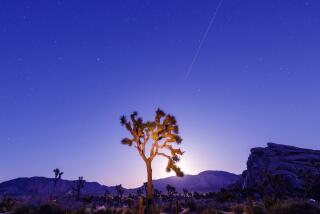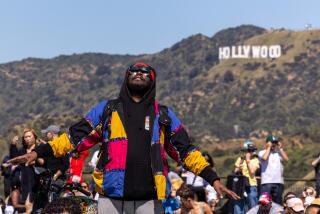Great Read: Teens launch balloons to edge of space, and so the adventure begins
High in the Eastern Sierra, a pack of huskies is howling in the shadow of snow-covered peaks.
Drawn by their song, 10 teenage members of the Earth to Sky Calculus club break from their work and gather on a cabin deck. Before long, they’re howling too.
It’s the Friday night of a long weekend and summer is almost here. A brand-new meteor shower is supposed to peak tonight, and in just a few minutes these teens will release a high-altitude balloon to the edge of space, hoping to record a shooting star.
As the first stars emerge, the students secure the payload — a soft, insulated lunchbox — to the bottom of the balloon. Inside is a low-light camera to record the meteors, an altimeter to measure altitude and a thermometer to gauge the changes along an ascent that could take the balloon as high as 22 miles above ground. Two GPS trackers are mounted on the outside of the payload to help them find it later.
Over the last four years, this tightknit group has launched 53 balloons into the stratosphere. It’s a long-running science project with a twist: part astronomy experiment, part backcountry adventure.
Aaron Lamb lies flat on his back and inflates the balloon with a tank of helium until it grows to the size of a Smart car. He bought the helium for $150 that morning, driving seven hours round trip with his friend Carson Reid to get it.
“It wasn’t too bad,” Lamb says. Reid agrees. For kids who grow up around here, lengthy road trips are a way of life.
As launch time nears, some are concerned that the balloon is lopsided. There is an argument about the formula for measuring circumference. Finally, it’s time for liftoff.
“Five, four, three, two, one,” they chant, and the balloon begins to rise. Reid follows it with a powerful flashlight for a few moments, illuminating the creamy orb in the moonless sky.
There is quiet, and a palpable feeling of collective wonder. Then the balloon disappears into the night.
When the launch is over, most of the students go home, but a few stay to watch the meteor shower. They lie on blankets and gaze at a sky so clear, it’s hard to believe you’re just four hours from Los Angeles.
Reid climbs into a sleeping bag that smells of dog and promptly falls asleep.
“We’re the only ones talking,” says Amelia Koske-Phillips.
“I know, it’s awkward,” says her friend Bronwyn Stephenson.
A meteor shoots across the middle of the star-studded sky.
::
The students of the Earth to Sky Calculus club live in and around Bishop, a mountain town surrounded almost entirely by wilderness. To the southeast is Death Valley, to the west is the Sierra Nevada mountain range. Mt. Whitney, the tallest peak in the continental U.S., is just 60 miles south.
They are bright kids, and many of them are headed to good colleges in the fall, but this balloon project would not have happened if it hadn’t been for Koske-Phillips’ soft-spoken dad, Tony Phillips.
Phillips is an astrophysicist who once worked for Caltech. Now he works as a science writer for NASA and runs spaceweather.com, a popular website that tracks phenomena like solar flares, meteor showers and radiation storms.
He’s also a dog lover. (Those 10 howling huskies are his.)
Earth to Sky Calculus began seven years ago, when Phillips started teaching calculus to his daughter and a few of her friends during their lunch break at school. The kids were in fifth grade at the time.
“I had this idea that we teach calculus backwards, and if you taught it in a different way, you could teach it in elementary school,” he said.
In middle school, the group moved on to physics, then quantum physics. By the time they were in high school, Phillips decided to make the class more hands-on.
So far they’ve tried sending a balloon into a thunderstorm to record lightning (that didn’t work out), and a balloon with extremophile bacteria attached to the outside of the payload to see if they would survive the high levels of cosmic and ultraviolet radiation at the top of the atmosphere (they did).
They’ve tried to measure changes in the ozone layer during a solar storm, and on the anniversary of the Voyager I spacecraft launch, they sent a rubber chicken into space with a “golden iPod” — their version of Voyager’s iconic, but to their minds dated, golden record. (Sorry Ann Druyan.)
There have been a few money-making ventures too. (For $50 you can have them send up a picture of your dad for a Father’s Day card that is “out of this world.”)
The balloon is almost always launched with a lightweight GoPro camera that captures soaring images of its journey as well as the curvature of the Earth at the pinnacle of its ascent. It also captures the spectacular destruction of the balloon once it gets too high.
As the balloon journeys up and up, the air pressure lessens and the balloon expands until it’s almost the size of a house. Then it pops in a dramatic explosion of talcum powder and balloon shreds.
A parachute attached to the insulated lunchbox helps the equipment inside land safely back on Earth. The students find it using the GPS trackers as a guide.
And that’s when things get crazy.
::
Recoveries are never simple. There is little inhabited land around Bishop, so the balloon almost always lands somewhere in the middle of nowhere.
Members of the group share their recovery tales like a vet rattling off war stories. There was that time when Reid and Phillips got caught in a sandstorm on the outskirts of Death Valley National Park. The GPS point they were tracking kept moving, because the winds picked up the lunchbox and scattered the contents across the desert.
There was the time Phillips, Reid and Michael White hiked for 20 hours straight into the backcountry of the Sierra to a place called McGee Lake. They did an elevation gain of 7,000 feet, and the average altitude of the hike was 11,000 feet.
Then there was the time the payload fell onto the John Muir Trail directly in the path of a young hiker from Alaska. The GoPro was still running when the hiker picked it up, and Earth to Sky Calculus has video of the hiker waving to the camera, and telling everyone he meets that a lunchbox just fell out of the sky.
Their longest recovery was when a lunchbox landed in Nevada’s Area 51. It took them six months to get that one back from the government.
“To me, recoveries are a huge part of the program,” said Phillips, who notes they’ve lost only two payloads in 53 launches. “Part of the journey has been getting to know this area in a way you never, ever would.”
::
Early Saturday after the night of the launch, Phillips plugged the coordinates from the payload’s GPS into Google Earth. Then he started calling around for hotels near the town of Three Rivers.
The payload had landed 52 miles west of Bishop, but to get to it, the recovery team would need to spend seven hours in the car — driving south of the Sierra and then back up the western side of the mountain range.
The actual hiking would be beautiful, through sequoia groves and past waterfalls. But things could turn perilous if the payload landed on a high peak — or even worse, up one of those majestic trees.
On some of the easier recoveries, half a dozen people will collect the lunchbox, but this time it was just Phillips and White. Of all the experienced hikers in the group, White is the most skilled. His parents took him on his first backpacking trip when he was just 4 months old. In February, he scaled Mt. Kilimanjaro.
“It’s important to keep in mind that these students are native to the Eastern Sierra,” Phillips said. “What may seem wild and dangerous to an outsider is, to them, just home.”
White and Phillips thought the retrieval may not be too bad. It appeared that the payload had fallen in a canyon less than two miles from a marked trail.
After spending the night in a one-room cabin, they drove an hour up a twisty road into Sequoia National Park. They marched briskly up a 3.7-mile trail that ascended 2,500 feet.
They turned left and followed a poorly marked trail for 1.7 more miles along a mountain ridge. And then things stopped being easy. The last half-mile to get to the payload took Phillips and White five hours.
Part of the problem was that they went into the wrong canyon — twice. Another issue was the slopes. They were steep, and when they weren’t covered in rock, they were covered in a hundred years of decayed pine needles.
“You are digging your fingers as deeply as you can into the dirt and pulling yourself up,” Phillips said. “Occasionally we could grasp a tree branch and that would help.”
They finally found the payload in the third canyon. White spotted it first, high on a flat rock, in the middle of a cascading waterfall.
They had entered the forest at 11 a.m. They emerged 11 hours later, headlights bobbing, payload in hand.
::
In the end, the camera didn’t record any meteors. Phillips has a few theories as to why. The Camelopardalids shower wasn’t nearly as prolific as some had hoped. Also, for the first time in their four ballooning years, the upper reaches of the stratosphere were turbulent, rather than tranquil.
“Even at 100,000 feet, the balloon was rocking along, so the stars were zooming in and out of the field of view,” he said. “They almost look like meteors.”
Sure, it’s a bit of a disappointment, but it’s also a perfect opportunity to discuss atmospheric waves, and how they might work above mountain ridges.
And it’s also one more tale of adventure to share with anyone who asks.
Twitter: @DeborahNetburn







